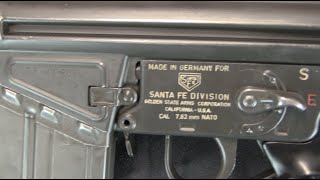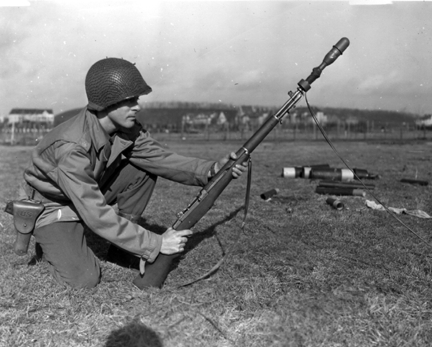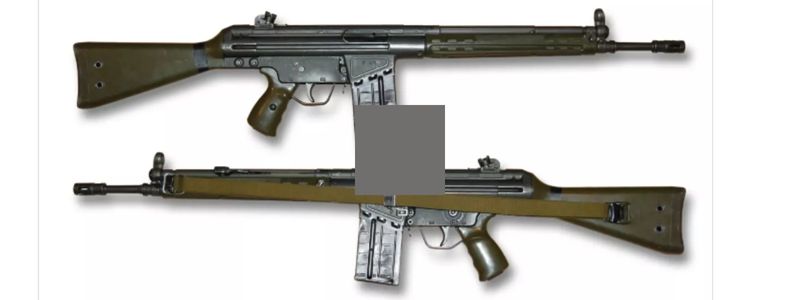Introduction to the G3 Rifle
While the HKG3 isn’t as widely known as the AK-47, it still holds a historical significance. It was used in the Second World War and is still used by numerous countries.

But if you’re looking to get your hands on one, learning what the weapon is like before spending any money on it is a good idea.
In this post, I will briefly review the G3 Rifle and discuss its interesting history.
G3 Rifle Review
Like most German products, the HKG3 boasts an outstanding design, and its superb execution makes it all the more impressive.
In addition to being utterly reliable and reasonably portable, the weapon also offers target accuracy.
There’s very little to criticize about the G3. The only gripe some have with it is that it’s relatively less potent than other 7.62 NATO guns out there.
However, it’s also important to consider that the appeal of lighter, easier-to-carry weapons has worn out over the years. While having a featherweight 7.62 weapon does hold its appeal for some, most want to get their hands on a more powerful rifle regardless of if they’re new to guns or trained experts.
History of the G3 Rifle
In 1948, four years after the Second World War had ended, three engineers from Mauser opened up a machine tool plant at their old site. They salvaged what they could and began to manufacture everything from sewing machine parts to bicycles.
The things they had salvaged from the former Mauser plant made manufacturing a little easier to get into.
About a year later, the three registered a company in their name – Heckler & Koch.
Around the same time, West Germany had put out a bid request for a new rifle for its army. H&K stepped up to the occasion and created their version of the Spanish CETME rifle.
It was a delayed-roller-blowback gun, which made it a lot lighter than gas-operated weapons. However, the gun had a problem – the cases would stick inside the chambers and tear off the extractors.
After finding out about the issue, the government of West Germany requested that a new rifle be chambered. But this time, they wanted it to work with the NATO round.
Heckler & Koch’s second gun was called the Model B and used the NATO round. Additional improvements were made to the design, enabling users to fire from a closed bolt in both semi-automatic and fully-automatic modes.

The Model B featured a longer barrel and had a 22mm grenade launcher guide. It also comprised a perforated sheet metal fore-end, enabling the barrel to cool faster.
Early Samples
It didn’t take long for the Model B to gain popularity. However, West Germany wanted the rifles to be manufactured in Germany.
Negotiating with H&K took quite a while; however, the manufacturing rights for the G3 (Gewehr 3) were eventually awarded to H&K. Another West German contractor, Rheinmetall, was also given manufacturing rights; however, the contractor gave up the rights in 1969.
The earliest production samples came with a flip-up rear sight that had two apertures. It also had a wooden butt-stock and a folding bipod.
Later, the flip-up sight was replaced with a rotating diopter sight. The new sight had a V-notch zeroed with ball ammo to 100 meters. There were three more apertures incorporated, zeroed to 200, 300, and 400 meters, respectively.
In the next version, the wooden stock was replaced with a more ergonomic polymer stock, and this is the version that would eventually become the G3A3.
While the G3A4 only featured minor improvements, its next version featured a removable bipod and a heat shield in the barrel channel.
The superb construction of the G3 made is extremely popular, primarily because it made it that much more reliable. Some even say that the dirtier the G3 got, the more reliable it became.
Usage
The G3 rifle was eventually adopted by more than 40 countries in all parts of the world, from Afghanistan to South Africa. Many countries also licensed and manufactured their own variants of the rifle for use by their military.
The rifle is still in use today in numerous countries.
Features
The G3 is modular – the butt-stock, grip, and fore-stock can be changed in a variety of ways with ease. The components are held in place by simple push-pins, allowing the user to replace the parts quickly, even when they’re on the move.
One of the best things about the rifle is that it uses easy-to-find, cost-saving steel components in favor of precision-machined parts. If the gun suffers damage, repairing it is easy.
However, if a G3 is severely dented on the field, it can suffer from impairment of internal parts, causing reliability problems. While heavy denting cannot be fixed on the field, specially designed mandrels can quickly fix the issue.
Trigger
The G3’s trigger mechanism features a three-position fire selector switch. You can toggle between its two fire modes – single-fire and automatic fire by sliding the safety toggle to “E” and “F” respectively.
The third fire mode is the safety mode, and the trigger is mechanically disabled.
As mentioned earlier, the G3 is a modular rifle, and it is possible for a user to fit a four-position fire selector group, which includes an ambidextrous lever.
The fourth selector setting enables a three-round burst fire mode, making the G3 a lot more versatile than it originally was.
Accessories
The G3 comes with a standard set of accessories that include a detachable bipod, a sling, a speed-loading device, and a cleaning kit.
Several different styles of bayonet are available for purchase for the G3; however, most models require you to fit an adapter into the end of the cocking tube.
Additionally, one can also mount a 40mm HK79 to the G3, which is an under-barrel grenade launcher.
Some other accessories available for the G3 include a firing adapter, a straight blowback bolt, and a conversion kit for training purposes.
Sound suppressors are also available for the G3, making it one of the lightest and most versatile weapons ever produced.



